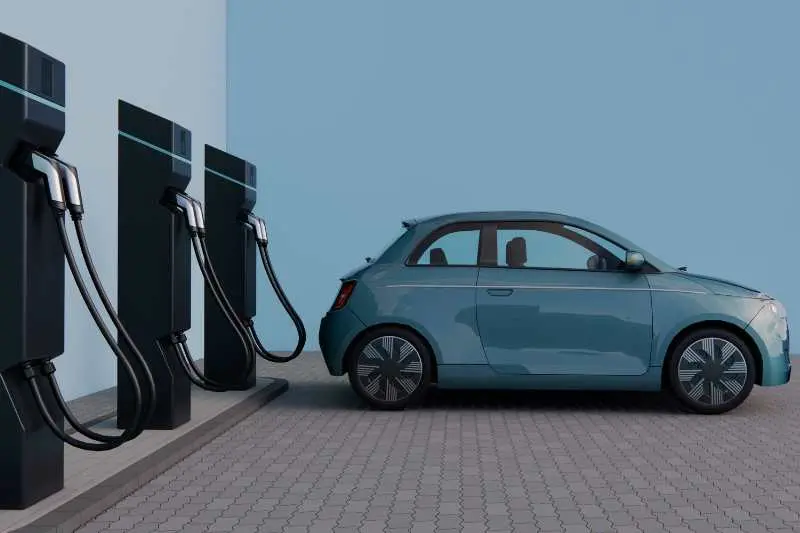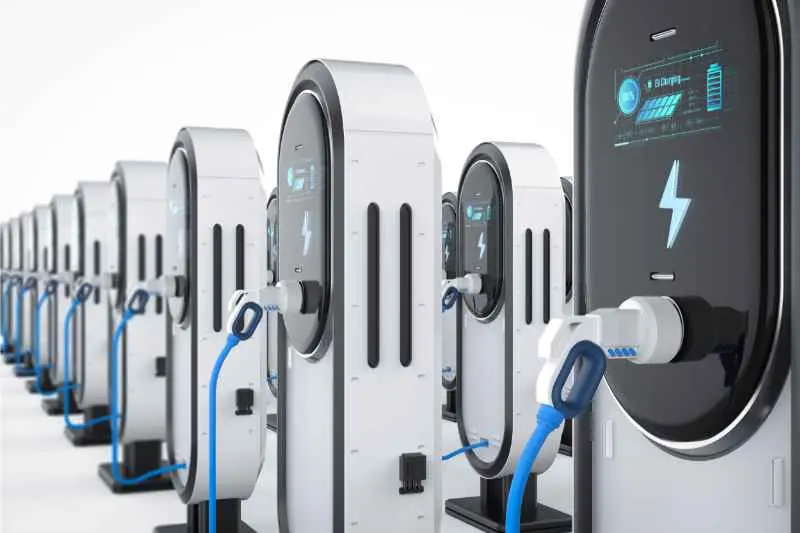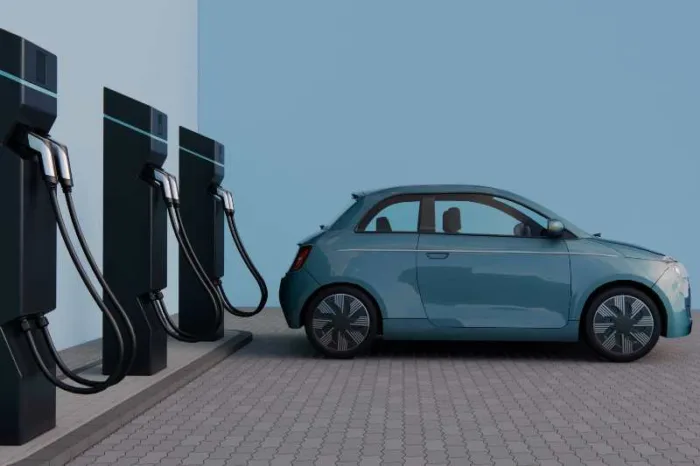Key takeaways
- Workplace EV charging stations are where employees can charge their electric vehicles in their employer’s parking facility while at work.
- The benefits of workplace EV charging are increased environmental protection, employee satisfaction, and a favorable public perception.
- The types of EV charging stations include level 1, level 2, and level 3.
- When managing an EV charging station, you’ll need to consider parking lot access control, liability waivers, and the type of charging station you want.

Electric vehicles are more popular than ever. Just about every major car company is releasing a line of electric vehicles. In a post-climate change world, electric vehicles are increasingly supported by companies and sustainable office buildings. As a result, workplace EV charging stations are becoming a must-have for commercial parking spaces.
With that said, this blog will detail everything you need to know about workplace EV charging stations. First, we’ll cover what EV charging is and why it’s important. Next, we’ll review the different types of charging stations. Finally, we’ll give a rundown of how much EV charging will cost you.
This post covers:
- What is EV charging?
- Why is workplace charging important?
- The types of workplace EV charging stations
- How much does workplace EV charging cost?
- Management tips for a workplace EV charging station
What is EV charging?
Electric vehicle charging is the method by which an electric vehicle gets power to operate. Many sustainable workplaces install workplace EV charging stations at their parking facilities. Workplace charging stations usually offer free charging for employees who are EV drivers.
Charging stations work when electric cars attach to a charging station via a cable. Then, it often takes several hours for a vehicle to be fully charged. EV charging stations are growing in popularity and are even being considered as an apartment amenity.
Why is workplace charging important?
Workplace charging is important because it has many benefits for your employees, your business, and the environment. It’s a smart way to combat climate change. Workplace EV charging stations will also change the dynamics of your commercial properties’ parking facilities.
Benefits of workplace EV charging include:
1. Environmental benefits
Electric vehicles are undoubtedly beneficial to the environment. Driving electric vehicles not only eliminates the need for gasoline and oil but also prevents these chemicals from being burned and released into the atmosphere. Reducing your organization’s carbon footprint by installing workplace charging will encourage employees to be more environmentally conscious, even if they don’t drive an electric vehicle.
Learn what sustainable is and how it can help beat climate change:
2. Employee satisfaction
With the threat of global warming on the rise, many people want to do everything that they can to reduce their carbon footprint. Additionally, electric vehicles are becoming more popular and more affordable every year. Hybrid (dual electric and gas) vehicles are also common and affordable. While many EV-driving employees likely have home charging stations, they likely have a long commute to your workplace.
Additionally, home chargers are not as fast as public-grade level 2 or level 3 chargers. By featuring workplace charging stations, you can reduce charging range anxiety. As a bonus, you can consider charging stations as another employee benefit.
Charging stations for employees are also beneficial because they spend upwards of nine hours a day at your workplace. The average electric car takes about seven to eight hours to charge from zero to full.
3. Public perception
Your workplace and/or company can become known as a sustainability leader. This might help you meet new decarbonization mandates in your local area. You can work in your sustainability practices as a marketing strategy for new employees, tenants, and even customers. Your sustainability practices will also appeal to key stakeholders in your business.
Being environmentally conscious is trendy, and it’s only going to get more popular as the threats of climate change continue to dominate the news cycle.
The types of charging stations for electric vehicles
There are several different types of charging stations for electric vehicles. Their differences have less to do with the brand names of electric vehicles (such as Tesla or GM) and more to do with the types of EV charges they provide.
The types of EV charging stations are broken down into three levels:
- Level 1 is for slow charging and runs on AC (alternating current). These are typically for private homes.
- Level 2 is for fast charging and runs on AC. This can be used for a workplace or otherwise public charging station.
- Level 3 is for rapid charging, and it runs on DC (direct current). This allows it to charge fast. Charging stations at this level will fully charge an EV within an hour.
Portable EV chargers are also common. They’re roughly the size of a backpack. While it might be nice to offer them to employees, a charging station is the better feature for your workplace.

How much does workplace EV charging cost?
The upfront cost to install EV charging infrastructure will, unfortunately, be rather expensive. However, the costs won’t be so high in the long run. EV chargers that provide seamless charging will only increase your total energy bill by about 4%.
Charging ports will cost you between $1,000 and $4,000. Naturally, the cost of each charging port increases with the level of charger that you choose. Installation for the total charging station will cost you between $2,000 and $10,000.
We recommend offering EV charging for free to your employees. However, if you own and operate a public parking lot or parking garage, then it is worth charging to “charge.” With a simple credit card system on the machines themselves, it won’t cost you much to monetize these systems.
Fair prices to charge at a level 2 charger range between $.20 and $.25 per kWh (kilowatt hour). For a level 3 charger, it will cost between $.50 and $.60 per kWh.
Can you write off EV charging?
New York State offers a tax credit of up to $5,000 for buying and installing an EV charging station. Your state may offer similar credits and write-offs. Having an EV charging station might qualify you for a green building certification.
Management tips for a workplace EV charging station
Depending on how large your property is, your workplace EV charging station will require some additional management and oversight.
When managing your workplace EV charging station, you should keep in mind:
Parking facility access
If your parking lot or parking garage doesn’t have an access control system set up, you’re going to want to install one. Otherwise, you’re at risk of drivers using your EV charging station who are not affiliated with your building or company.
The ButterflyMX vehicle access control system offers a number of features for your parking facility that will help you manage who uses your charging station.
The ButterflyMX vehicle access control system features:
- RFID windshield tags. You can outfit employees’ cars with these. When they pull up to a gate, the access control system will verify their credentials through the tag and grant them access.
- Date- and time-stamped entry events. Every entry event is logged, recorded, and stored in the cloud, where it can be viewed at any time, increasing the overall security of your property.
- Video intercom. Tenants and employees can communicate face-to-face with visitors, offering peace of mind when letting guests inside.
- Remote entry. Users can let guests into the property remotely. Guests and visitors can also receive temporary QR codes that will grant them access to your property. In turn, access is more convenient and simple.
- Keyless entry. In addition to windshield tags, users can enter by downloading and using the app on their mobile device.
- Easy installation. No complicated wiring is required, reducing the cost and time needed for installation.
Type of charging station
Will you choose a level 2 or level 3 charging station? And if so, how many charging ports will you offer? Despite costing more to purchase and install, a level 3 charging station charges vehicles quickly. In theory, you could offer fewer level 3 charging ports and devise a system or schedule for when employees can charge their vehicles on a daily basis.
Additionally, you could assign individual employees specific charging ports that they can use daily. Consider the possibility that future employees will likely purchase a hybrid or fully electric vehicle.
Waiving liability
You’ll want to ensure that every employee signs a liability waiver before using your charging station. This will ensure that they know what they are doing when they charge their vehicle. This waiver will also protect you should any unintentional damage happen to an employee’s electric vehicle.








